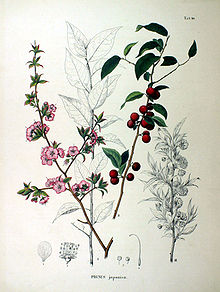- Prunus japonica
-
Prunus japonica 
Korean cherry (Prunus japonica) Scientific classification Kingdom: Plantae (unranked): Angiosperms (unranked): Eudicots (unranked): Rosids Order: Rosales Family: Rosaceae Genus: Prunus Subgenus: Cerasus Species: P. japonica Binomial name Prunus japonica
Thunb.Prunus japonica (also Cerasus japonica), also called Korean cherry, Flowering almond or Oriental bush cherry, is a shrub species in the genus Prunus, that is widely cultivated for ornamental use. Its native range extends from Central China through to the Korean peninsula. P. maximowiczii, the Miyama cherry is also often referred to as Korean cherry.
Contents
Description
The shrub reaches 1.5 m by 1.5 m. Its flowers are hermaphrodite and are pollinated by insects. The plant blossoms in May. Its fruit reaches about 14 mm and has an agreeably sweet flavor, therefore it is used in making pies, but its taste is quite sour, reminiscent of that of Sour cherry.
Every fruit has one seed. The plant usually grows from seed but can also be multiplied by cutting for layering.
Habitat
The plant thrives on well-drained and moist loamy soil and prefers little shade or no shade at all. The plant prefers some lime in the soil but not too much. It is mostly found at woodlands or sunny places.
Medical interest
Although this is not yet scientifically established, the species is thought[by whom?] to contain amygdalin and prunasin, as is the case at all the other members of the genus Prunus. These chemical compounds break down in water to form hydrocyanic acid, an extremely poisonous substance that when taken in very small amount can stimulate respiration and improve digestion.[medical citation needed]
The kernel of Prunus japonica is highly versatile: it is deobstruent, aperient, demulcent, carminative, diuretic, laxative, hypotensive, ophthalmic and lenitive. It can also be prescribed for internal use in treating dry constipation, oedema or post-traumatic insomnia. Other part of the plant is also used, but more rarely. For instance, the root acts against constipation, child fever, pinworms and teeth problems.[medical citation needed]
Other uses
The leaves of this plant procure a green dye, while the fruit procures a greenish to grayish dye.
Varieties
There are several varieties:
- P. japonica eujaponica
- P. japonica gracillima
- P. kerii
- P. japonica nakaii, originated from Manchuria, which gives bigger plums (up to 50 mm in diameter).
See also
References
Categories:- Cherries
- Flora of Northeast Asia
- Flora of Japan
- Flora of Korea
Wikimedia Foundation. 2010.
